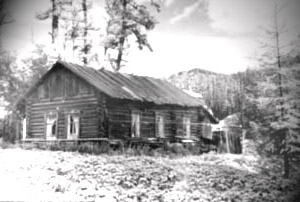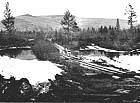EPIGRAPH
THE BEGINNING
THE HISTORY OF BAM
BAMLAG
AFTER THE WAR, BUT BEFORE BAM
THE CITY
THE BIG CITY
THE CELEBRITIES
THE ART AND SOCIAL LIFE
THE FIRST DECADE. 1975-1985.
CHRONOLOGY OF EVENTS.
THE BREAKING POINT
SOUL RELAXATION
CATASTROPHES
WHAT'S LACKING IN THE CITY
WOULD YOU LIKE MORE DETAILS?
TOWNS AND VILLAGES OF THE AREA
EPILOG


Tynda (Biased Notes)
THE BEGINNING
The history of Tynda City begins in 1975.
On 14th of November 1975, by the Decree of the RSFSR (Russian Soviet
Federative Socialist Republic) Supreme Soviet, a worker's settlement of
Tyndisky was reorganized into a city of Tynda with a Regional subordination.
However, everything had begun much earlier…
January of 1972. The first builders from a newly formed state construction
agency "BAMstroiput" arrived on the eastern side of the Tyndinsky
settlement. I guess they were the ones who laid the groundwork of the
future BAM capital.
In 1974 Central Committee of the Communist Party and the Soviet of the Ministers of the USSR issued a decree titled "In Regards to the Construction of the Baikal-Amur Railroad Mainline." On April 27th 1974, Moscow City was saying farewell to the first 606 Komsomol members (Communist Union of Youth), - deputies of the 17th Congress of VLKSM (All Union Lenin Communist Union of Youth), who were departing right from the Kremlin Palace of Congresses. A few days later, emissaries from Moscow, Leningrad, other Soviet Union republics and regions joined the collective of builders. The commander of the All-Union Komsomol squad of builders named after the 17th Congress of VLKSM was deputy of the Supreme Soviet of RSFSR, a hero of the Socialist Labor, an experienced transportation professional Viktor Ivanovich Lakomov. And the squad's commissar was a Muscovite Vladimir Vasilievich Muchitsyn. By the 3rd of May, Komsomol emissaries had begun their work simultaneously at several points of the future mainline: Lena, Nizhneangarsk, Tyndinsky, a temporary bridge across Selemdzha River, Urgal, Berezovka, Komsomolsk-on-Amur. On July 8th, Central Committee of the Communist Party issued a declaration "In Regards to the Construction of the Baikal-Amur Railroad Mainline." The declaration outlined the tasks for the party, Soviet, Komsomol and trade union organizations and the tasks of the related ministries and agencies. A special committee was formed to handle the organizational and technical aspects of the mainline development as well as to deal with any arising issues related to the construction. In the same year, they declared BAM an All-Union Forefront Komsomol Construction Project. Every year, tens of thousands of young people took the Komsomol challenge and went to the "Construction Project of the Century."
However, the first time BAM was referred to as " The Construction Project of the Century" was in the 1930's. And if we look even further, it was when there were camels around…
In 1865, mining engineer N. P. Anosov discovered gold in the Rivers of Dzhalinda and Yankan. In 1868, gold prospecting began on the territory of the current Tynda area, formerly known as Dzheltulaksk area. The gold rush attracted a mass of people. Some of them settled in the area permanently.
One can call these people different names: swindlers, pioneers or per N. Gumilev - the passionaries. The name is not important, but the matter is. And the gist of these people was the spirit of dissatisfaction and rebellion. You'd have to agree that it is rare that an "average Joe", even out of a dire need, will go beyond the known and inhabited territory. One needs a special character for that, a special urge and longing. Those types of people were the pioneers of the Wild West, Africa and also the revolutionaries. This rebellious spirit, this sense of dissatisfaction uprooted them out of their settled, quiet places and threw them to uncozy, nasty, scary and undiscovered corners. The thirst for unknown was fueled by the thirst for gold. And thousands of adventure seekers rushed to the Russian North.
By the beginning of the last century, there had been around 300 prospector settlements along the Rivers of Gilyui and Zeya. And that's when the convenient valley by the big water, protected from the winds by the wooded hills, was discovered by prospectors. They could rest here and camp over night.
Tynda was mentioned as a prospector's transit point for the first time in 1917. Around the same year a lodge appeared on the riverbank. The lodge belonged to an entrepreneurial (and probably shady) businessman Shkaruba. The lodge was on the way from Larinsk (today known as Bol'shoi Never) to the gold mining sites. One could warm up, have a meal, take a bath and drink some vodka at Shkaruba's place; all for a fee of course - gold dust.
In general, Amur Region holds up to 30% of the discovered gold deposits in the country. The gold is both alluvial and compact. Before and after the Revolution of 1917, one could find here something resembling Klondike of the Gold Rush era. People would come out of taiga all dirty, stinky, with fleas but also with a sack full of gold. And after a month or two of saloon entertainment, they would go back to taiga (that is of course if they did not get robbed or killed) broke and in debt.
The collected gold was transported under a heavily armed escort to Amur River on camels. Today the "Ship of the Desert" is exotics in the North. A few years ago, a traveling zoo visited Tynda. They had a camel as one of their exhibits. It was a pitiful and a sad exposition - the camel was sick-looking, always lying down on the floor of the cage with his eyes closed and his tongue out. He probably died later. But back in the day, a camel was preferred over a horse. A camel is stronger and more enduring. It better endures cold and does not require much care. When the first automobile roads were built, camels slowly disappeared in this area.
Later, in the 1930s, the State imposed a strict control over the gold miners. The State was purchasing the gold at fixed prices, and drove the independent gold purchasers out (after declaring that private gold trading was a felony). But all this was later. And now...
The young Soviet State and its chieftains needed plenty of gold. Lots of it. That is why after the end of the Civil War in the Far East, they began sending field research parties here. And by mid 1920s, rich alluvial gold deposits were discovered on the Aldan River.
Until 1926 Tynda, being at the crossroads of the prospector's routes, was just a trans-shipment base for the gold miners. These routes were the reindeer and horse paths and rivers. One could only use a river to reach some destinations, because a camel needs some path, an opening in a forest thicket. It is a large animal. For example, one could deliver a load of goods from Nyukzha to Tynda only on a river raft.
On 7/6/25 Central Executive Committee passed a decree to begin planned population of the areas of Volga River, Siberia and the Far Eastern regions. It was a start to exploration of these areas. The commissars probably remembered the words of Lomonosov that "Russia will grow through Siberia." Soon the construction of the Amur-Yakut Highway began. The highway was to connect the already inhabited but still developing regions of Yakutia with the Zabaikalsk railroad. This was the only decent road that ran through the Tynda area and the settlement, and it was well maintained. The rest of the roads were impassible by car or truck.
The construction of the Amur-Yakut Highway (AYH) is a story of its own. AHY followed the tracks of reindeer sleds and horse hooves. AYH was a reliable freight route that helped to speed up the arrival of rails to Tynda. Thanks to the construction of AYH, coal deposits were discovered in the Southern Yakutia and camels completely disappeared. Maybe some day, there would be a historian who'd tell the YAH story.
The first construction management base was set up on the 171st kilometer from Larba station. That was the future city of Tynda.
